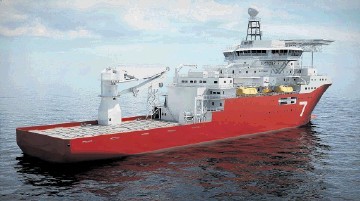
Contracting major Subsea 7 has been awarded a subsea, umbilical, riser, and flowline (SURF) contract valued at some $800million by Total for the development of the gasfield Martin Linge (formerly Hild) located 180km west of Bergen in the Norwegian sector of the North Sea, block 30/7.
The contract, a record for Norwegian subsea, comprises engineering, procurement, construction, and installation (EPIC) of the complete subsea facilities on the field including: a 160-km power cable from the Martin Linge platform to Kollsnes; a 70km export pipeline and associated valve structures, umbilical, and spools for the gas export system; a 55-km fibre-optic cable; and a 3km pipeline and riser system from the Martin Linge platform to the floating storage unit. The contract also includes transport and installation of the mooring system for the field’s floating storage unit.
Under the terms of the contract, Subsea 7 will deploy various pipelay, construction, diving, ploughing, trenching, and survey vessels during the offshore period.
The newly-delivered Seven Borealis, which adds considerable pipelay and construction firepower to Subsea 7’s fleet has been allocated the task of installing the Martin Linge gas export line.
Engineering and project management starts immediately at Subsea 7’s Stavanger office, with offshore operations due to get going in the spring of 2014.
Contract duration is to be around four years.
Stuart Fitzgerald, Subsea 7’s Norway vice president, said, “This project is the largest SURF contract ever awarded on the Norwegian Continental Shelf, and as such represents a step change for our sector in Norway.
“This project builds on the good experience we have had with Total in Norway over many years, including the recent successful delivery of the fast-track Atla tie-back project which commenced production during October.
“Subsea 7 looks forward to successfully delivering the Martin Linge project, with safety and quality at the forefront throughout.”
The 189million barrels oil equivalent Martin Linge development has been on Total’s list of potential candidate projects book for many years.
At one point this isolated discovery located close to the UK-Norway boundary was being considered as a tie-in candidate to Total’s Alwyn field complex.
Eventually Total opted for a standalone development, the capex of which is around $4.6billion.
Core of the project’s infrastructure is to be an integrated wellhead, living quarters and production facility with a life expectancy of 30 years. The facility will be remote controlled from an onshore base in Stavanger via an undersea cable from Kollsnes, and will also receive power from land.
Gas will be exported via a tie-in to UK gas transportation infrastructure. Associated oil will be piped to an infield storage vessel (capacity 620,000 barrels) for processing before loading aboard shuttle tankers for export.
The field is operated by Total with 51% interest in partnership with Petoro, holding 30%, and Statoil with 19%.
Meanwhile, Subsea 7 is maintaining investment momentum by ordering a new dive support vessel (DSV). The 123m vessel will be built by Hyundai in South Korea and is scheduled for delivery in 2015.
With accommodation for 110 people, the DSV will incorporate an 18-man saturation system supplied by Drass and rated for 300m with two moon-pool deployed three-man diving bells and two 18-man hyperbaric life-boats.
The vessel will be equipped with six main engines in three separate engine rooms designed to maximise performance in Dynamic Positioning (DP) Class III.
Subsea 7’s commercial VP, Steve Wisely said the company is working with HHI, Drass and Wartsila Ship Design to deliver the complex new generation vessel.
This will be the third new-build DSV to join the Subsea 7 fleet in recent years, having taken delivery of the Seven Atlantic in 2010 and Seven Havila in 2011.